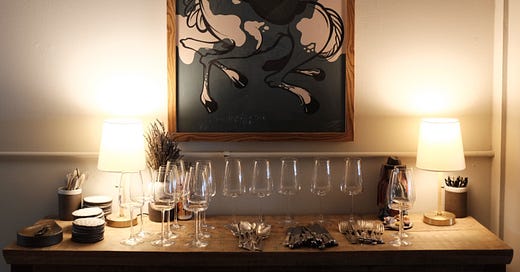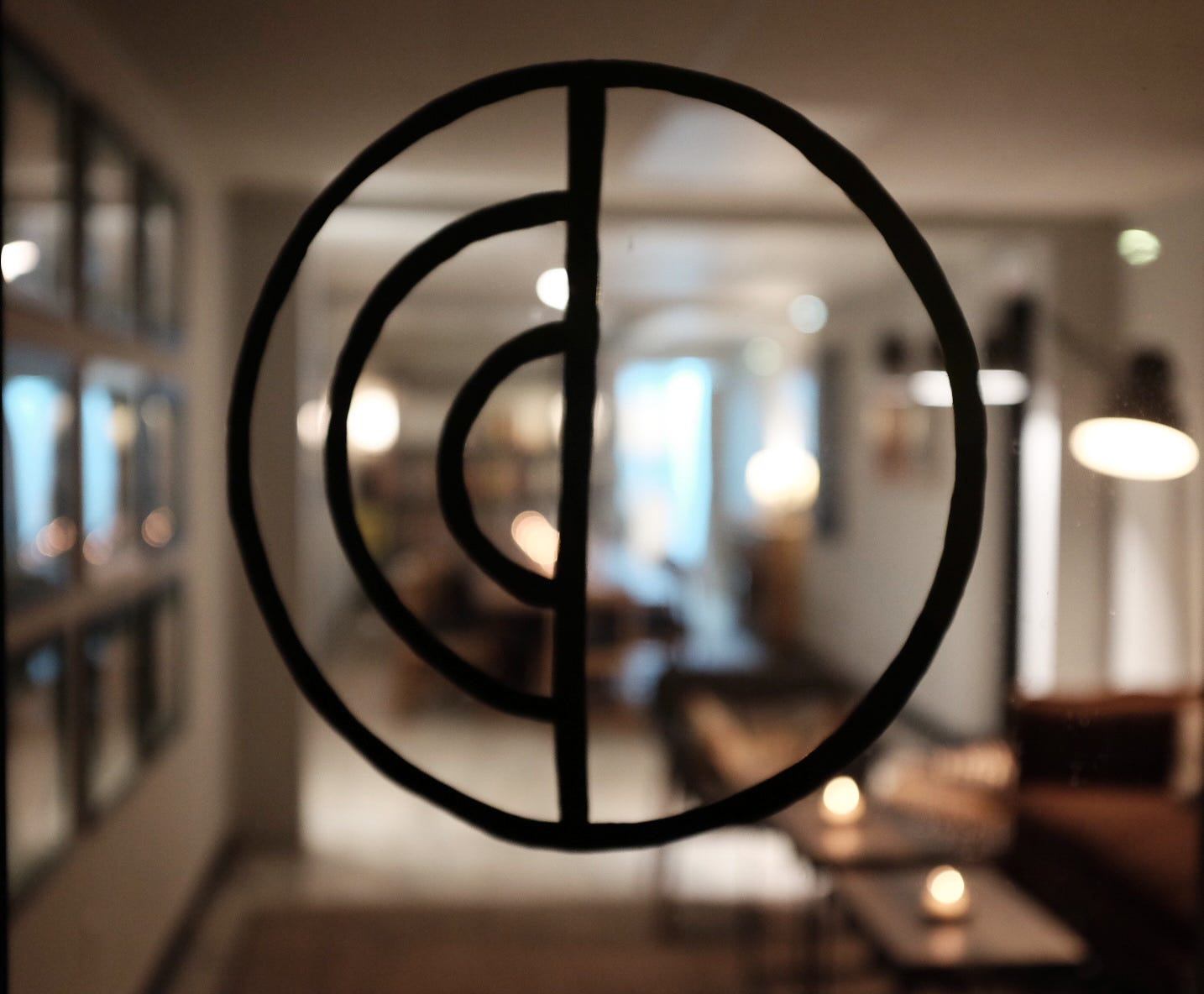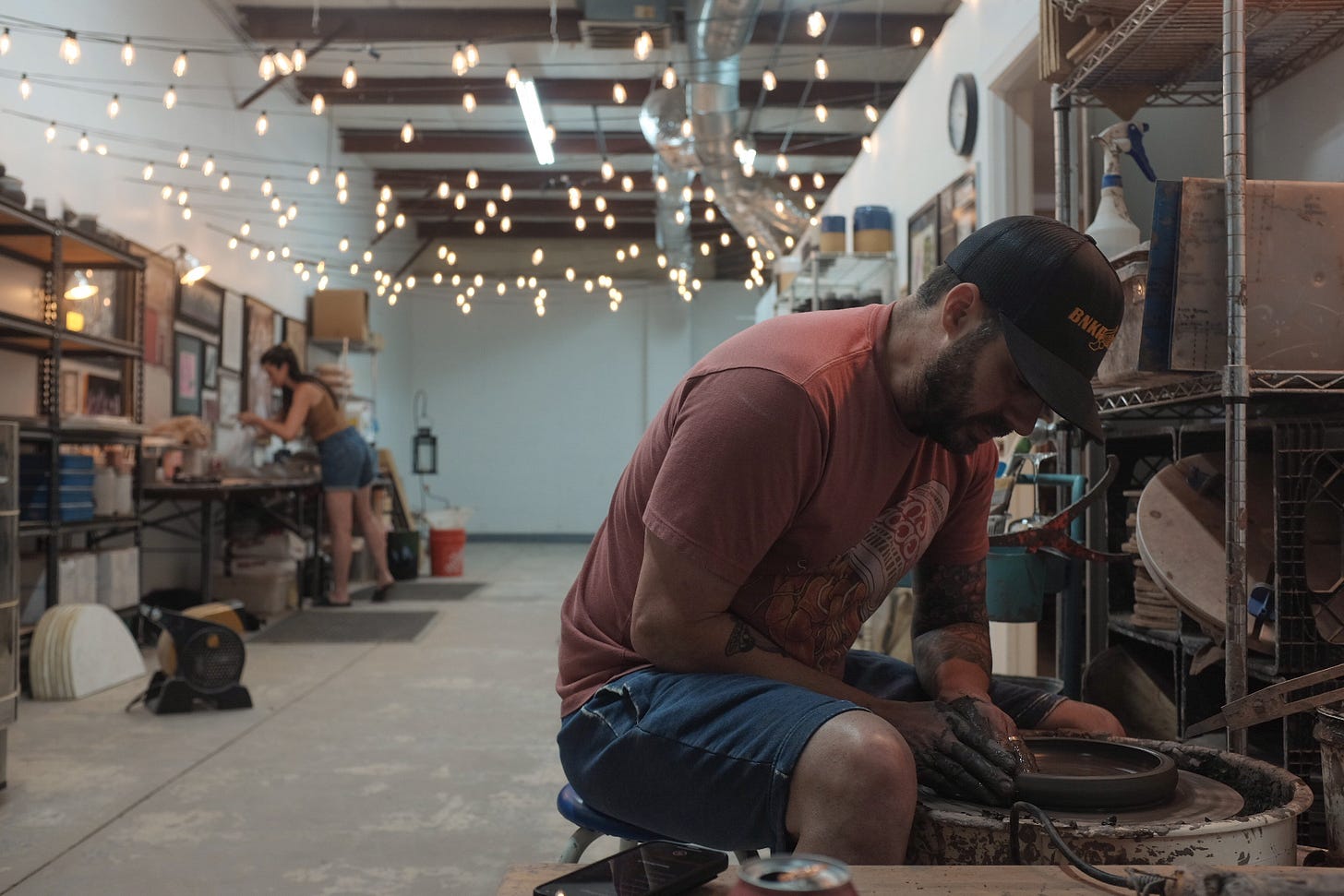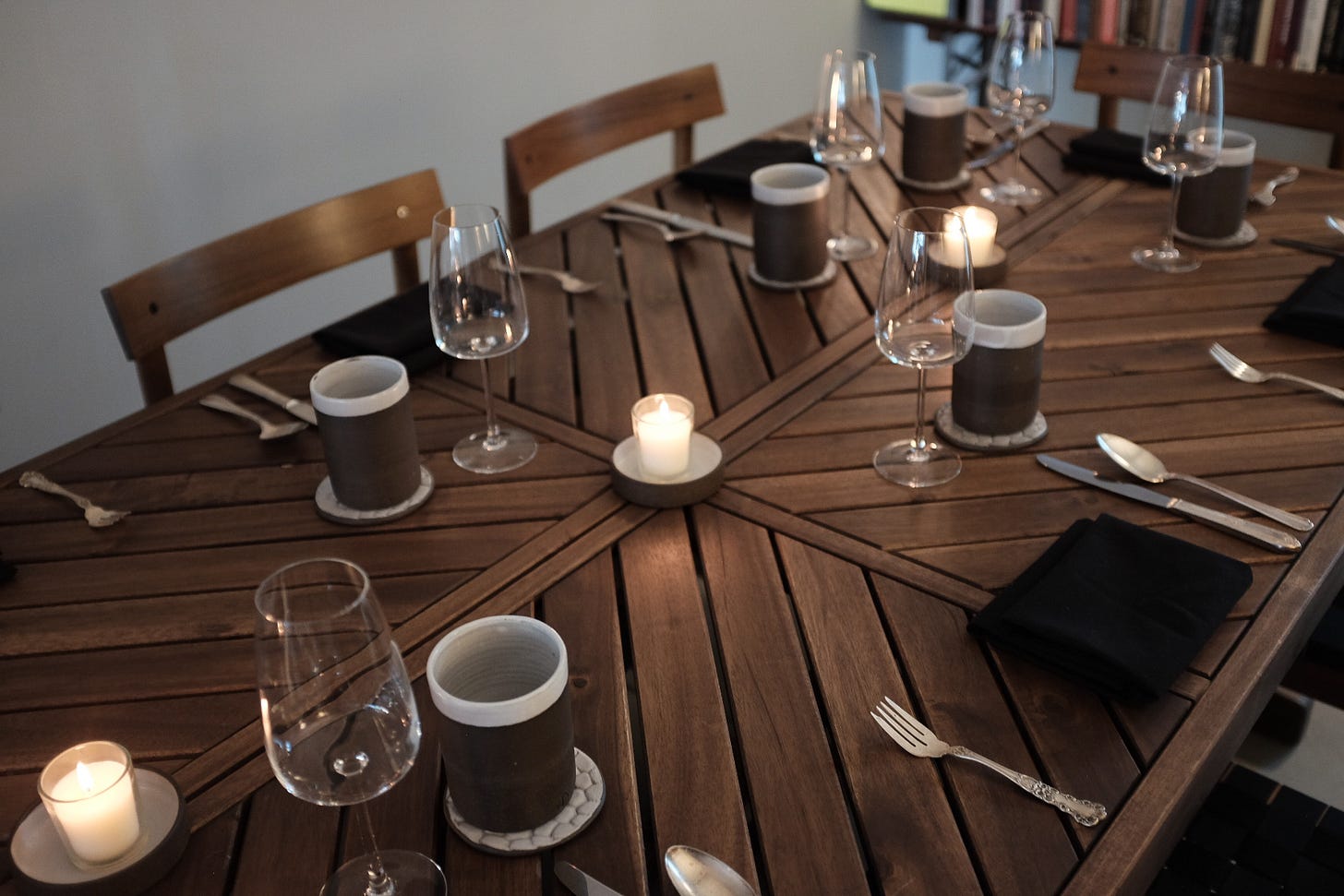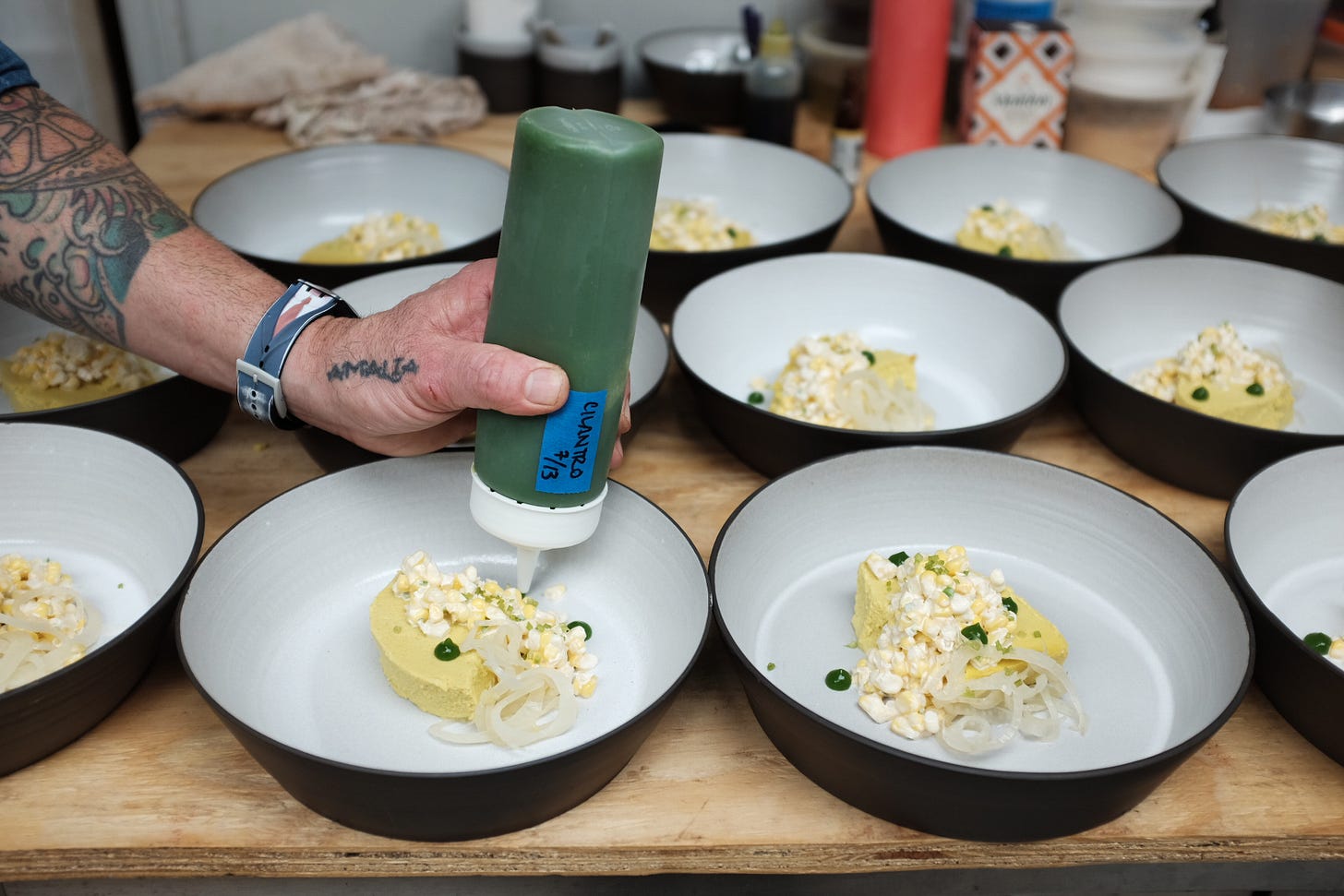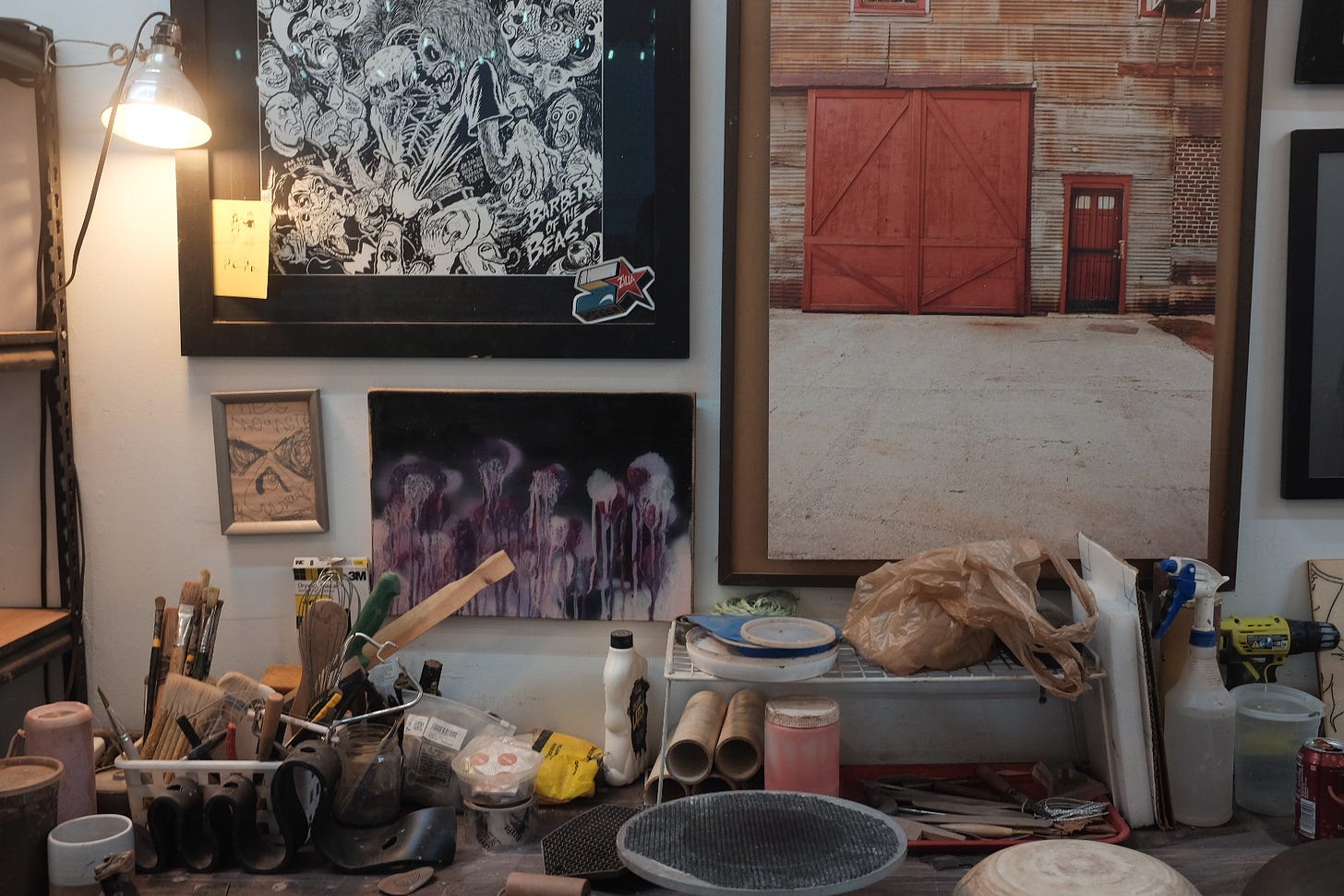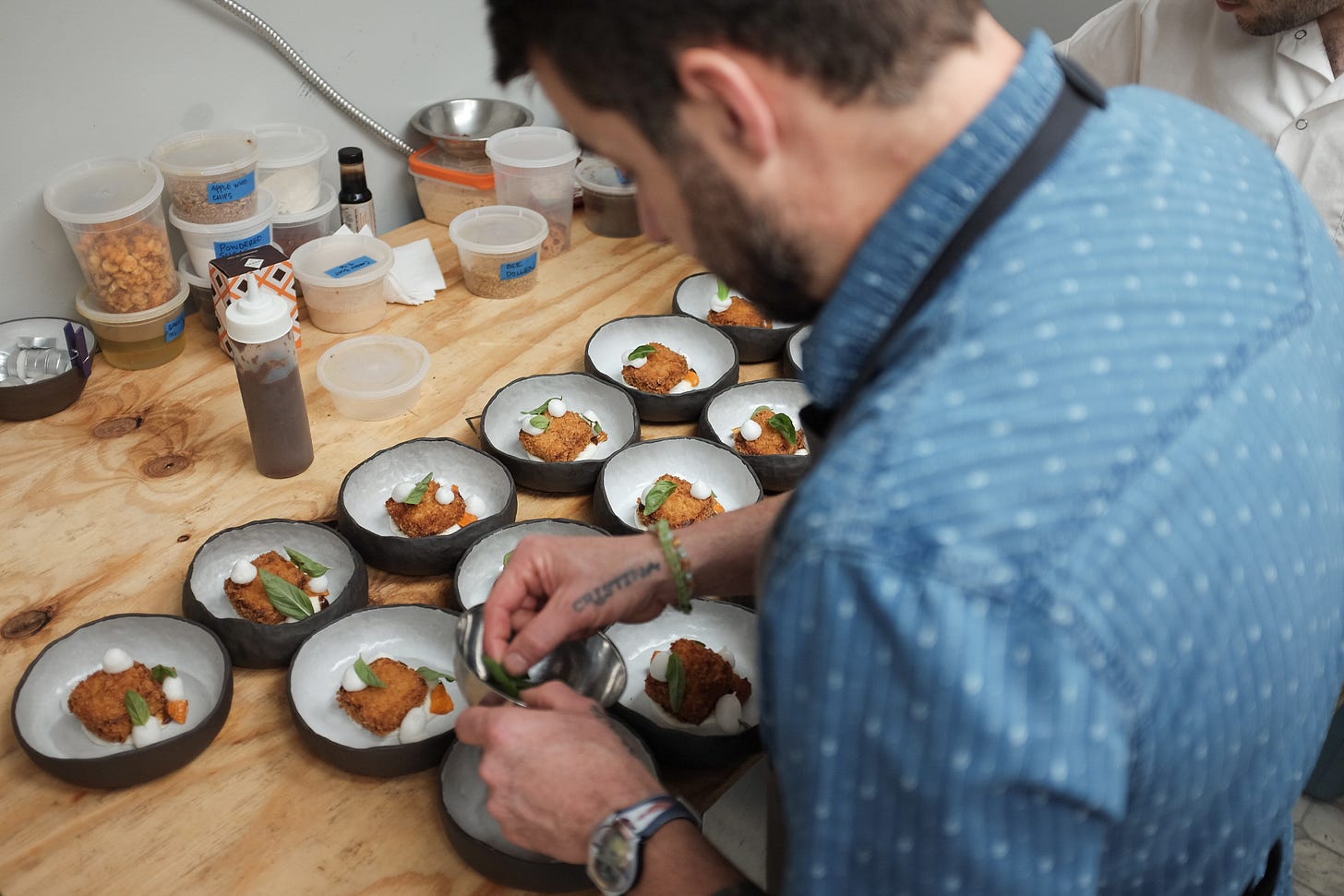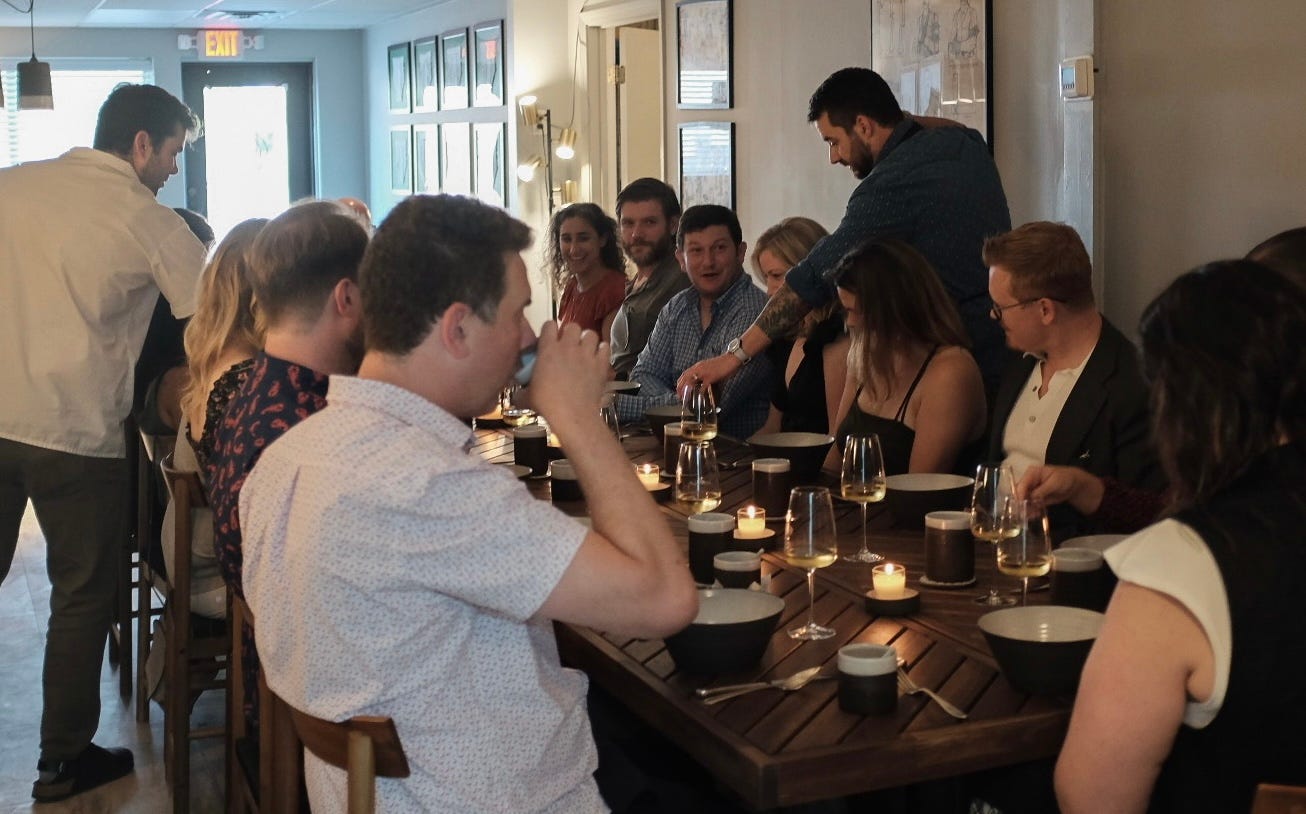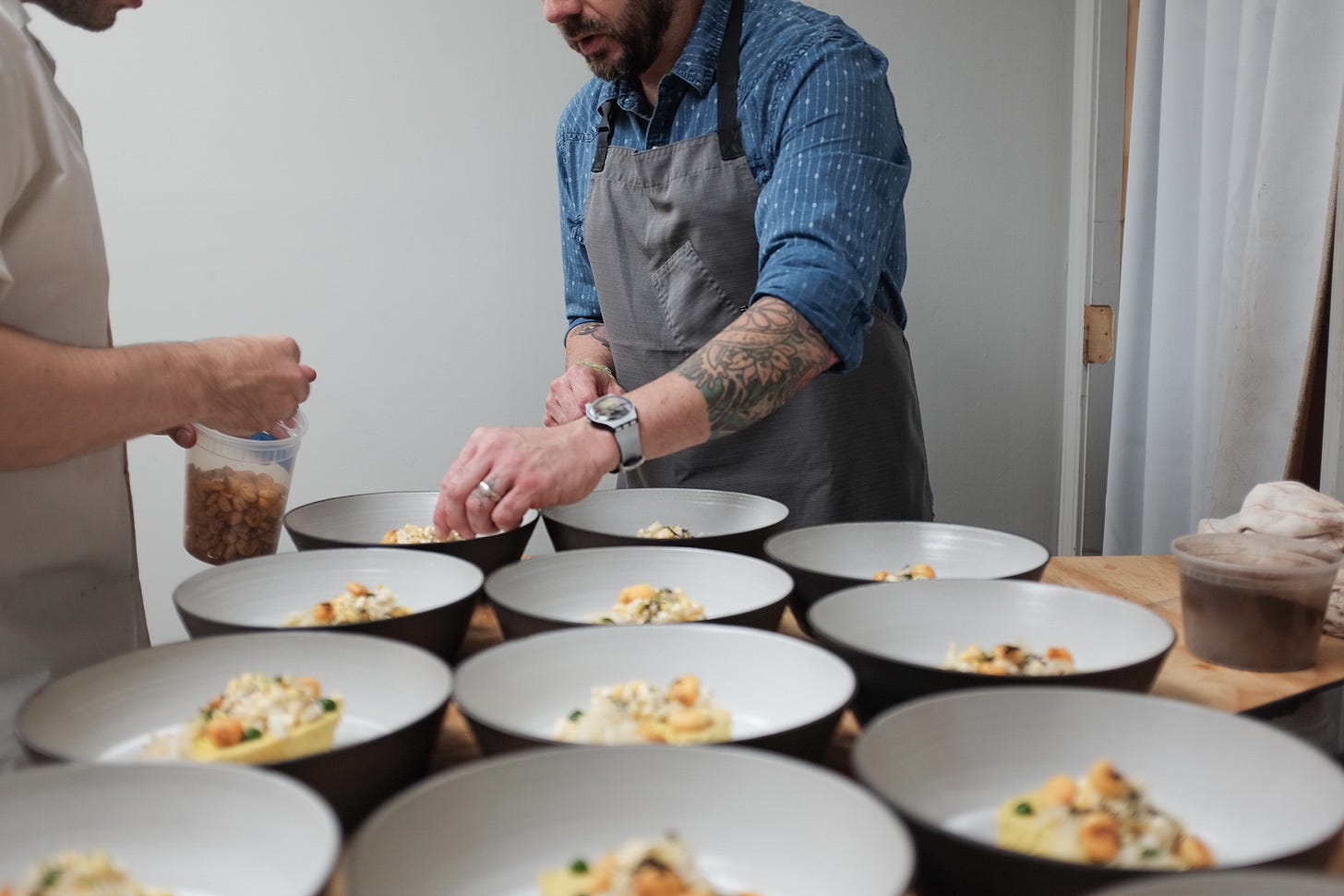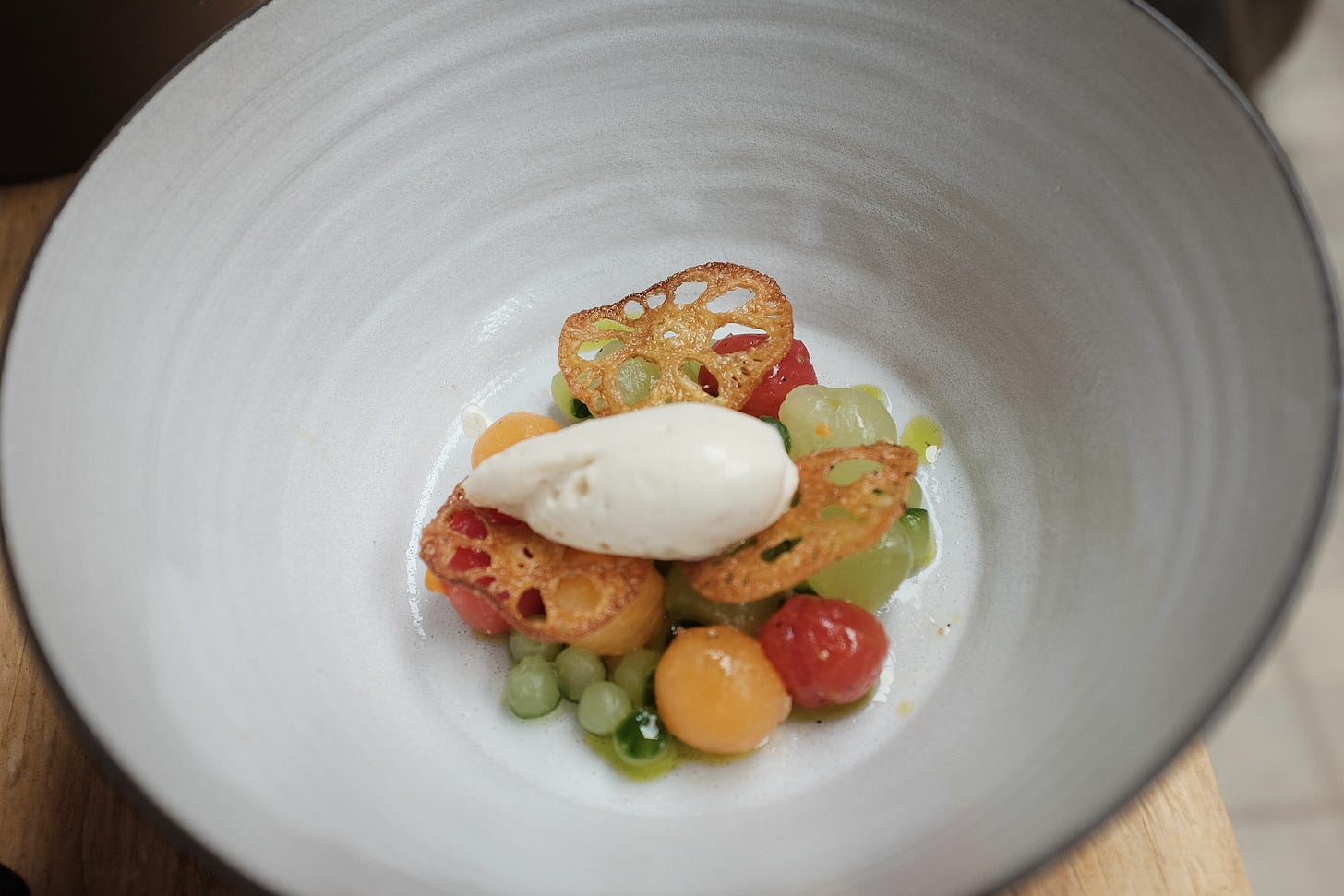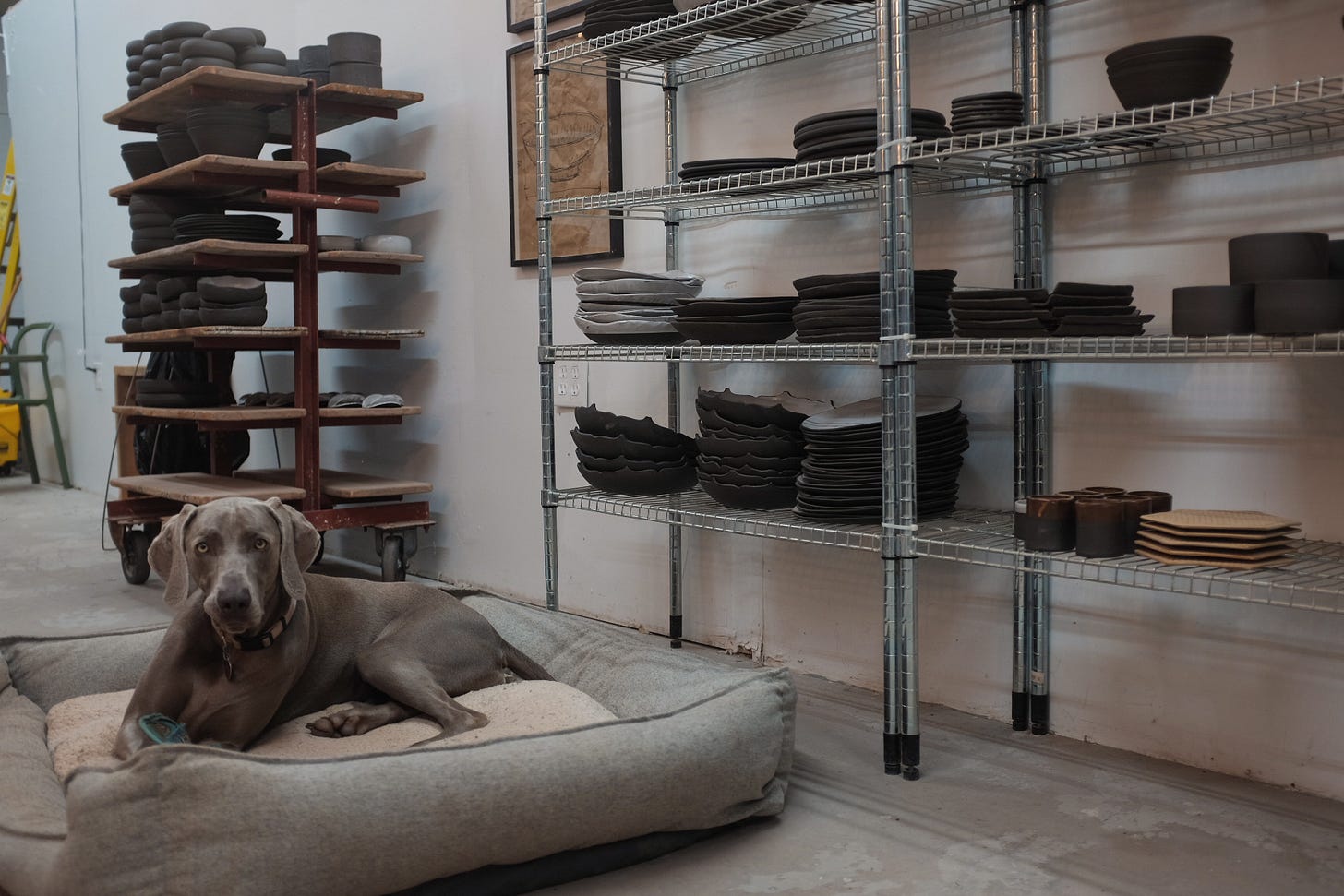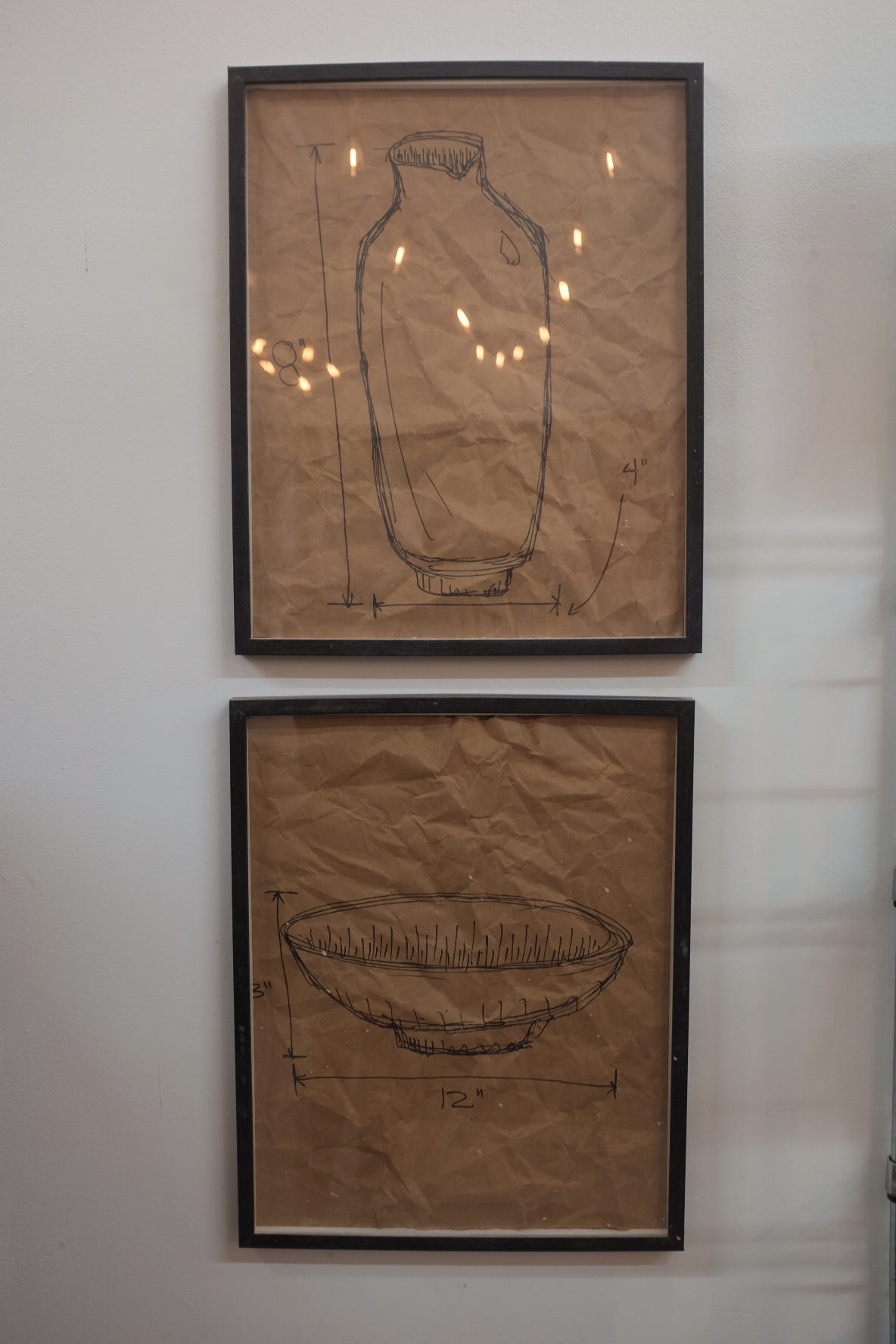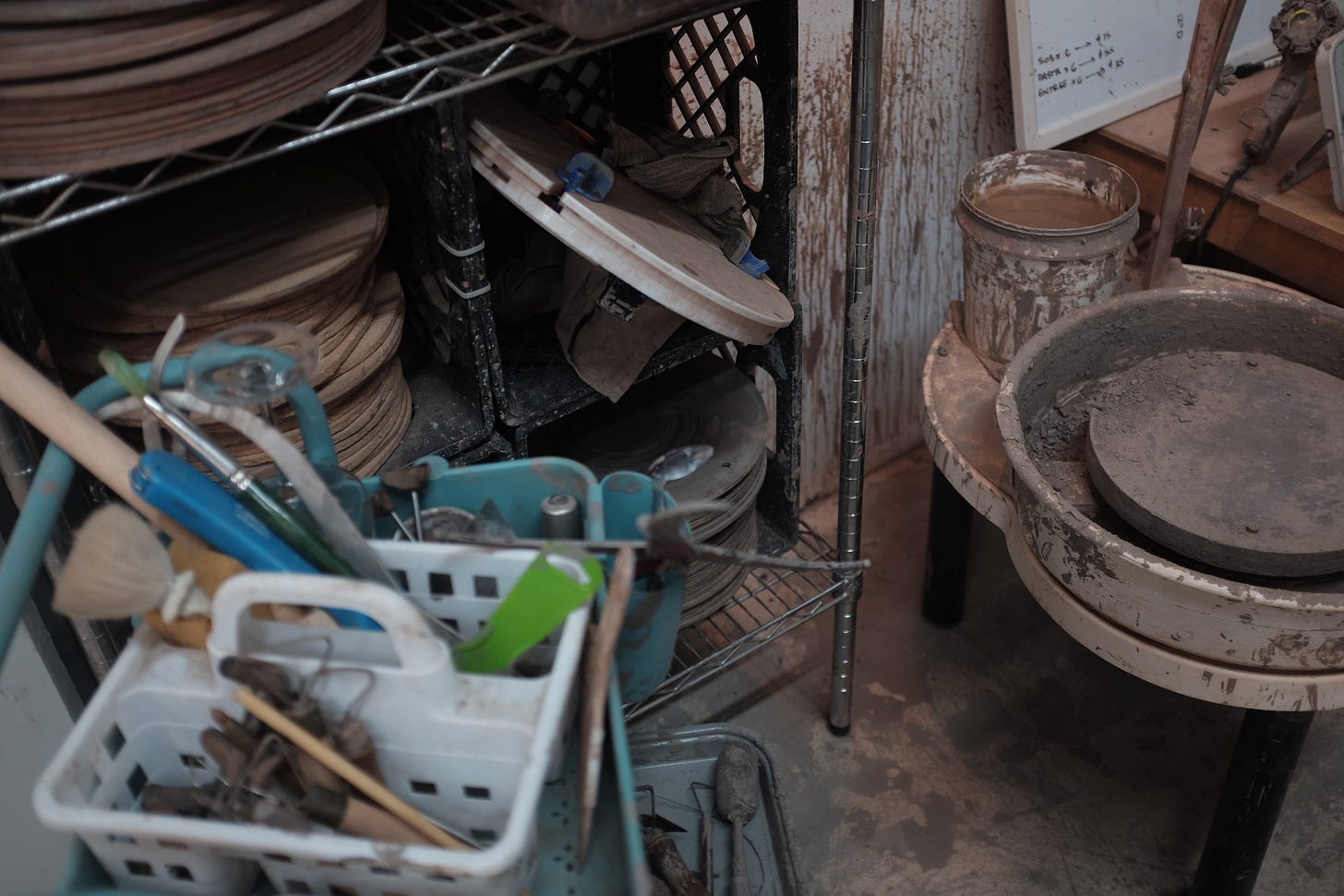*Crash* OPA!
Weddings, sporting events, and television marathons, all have something in common, and that’s food. Usually we’re asking questions like “would you like the chicken or the fish?” “ketchup or mustard?” “candy or popcorn?” but we’re often not given the chance to decide what that food is served on or in, whether that be a paper plate shaped like a zoo animal, a blue plastic tray, or your mother’s fine china when that special guest comes by the house. Salad plates, dessert plates, dinner plates, soup plates, and charger plates, are just a few examples of how plateware are utilized; heck I’ve even seen plates hung on a wall as art. Tableware has developed alongside humanity, with some of the earliest pieces being ceramics that have been dated back to 29,000 BC. Now local to Atlanta, there’s a small ceramics studio ran by Zach Meloy, an internationally recognized chef, father, and skilled ceramists. After having left the restaurant industry, Zach began to pursue the art of meal presentation from the bottom up. He now hosts a private supper club where he serves dishes that are not only cooked by him, but presented on tableware that he’s hand crafted himself. He calls it, his Dirt Church.
The Place: Dirt Church
What is the story behind Dirt Church?
It’s so hard to know where to actually begin telling that story because I really do believe that Dirt Church is kind of the culmination of my career path. It’s the synthesis, the bringing together of my trained profession, which is that of a chef, and then kind of working in different elements to that formula. So I think that ultimately the short answer is, I wanted to create a little social experiment for people to come and eat a seasonal meal, a menu, that was written and designed around plateware, that is also influenced by the food. The menu dictates the ceramics and in a lot of ways the ceramics dictate the food. I think that the idea came about over time and as I kind of moved away from the traditional restaurant setting, but still wanting to involve food and cooking, that’s kind of the genesis for this whole thing. To recognize that the traditional restaurant is doing a lot of us a disservice, the diner and the kitchen employee. So to figure out a way to alter the formula, was really the beginning of all of this, but the pandemic was ultimately what brought it all together, because I was just forced to sit down. I had recently closed my restaurant Better Half at the end of 2018 and I had taken a perspective chef job to open a restaurant out in the burbs and I was effectively waiting for the restaurant to be built out and produce the ceramics for it, just before the pandemic came through. Not only did the restaurant world stop spinning for a while there, but in a lot of ways it started spinning in the opposite direction and I was kind of given the rare opportunity to not just reflect on what I do for a job but why I do it for a job. That’s such just a rare opportunity that most of us never really get and I didn’t wanna waste that. I didn’t want to let that point of privilege go to waste. So this is kind of like my final form as a chef or at least almost the final form. We got one last move that I’m working towards. But the idea is, create a space, to surprise people. Give people an opportunity to let go and surrender in an effort to give them an experience that they didn’t really know they needed.
How do you select your menu?
So, I think that a lot of times for me, first and foremost, I don’t really make it clear to the diner what the theme of their menu is. We always start with season obviously, as any menu should. Then working from the season, I will kind of choose a theme, choose an activity, choose something that kind fo happens during that season. So we chose something that was a little more obvious like backyard barbecue, kind of like cookout scenario for this summertime menu. Then start incorporating ideas and elements, or flavors or aromas that you would find during one of those experiences and then work them into the menu and also the plateware as well.
What makes a dish restaurant quality?
I would say if we were going to ask the difference between home cooking and restaurant cooking, I would say the easiest answer right there is salt. I really think that when it comes down to it, I think it’s rare that the home cook sits down and is trying to convey a larger concept, a more obscure concept than just delicious food if that makes sense. There’s kind of this on going debate in the restaurant world “is food, art? or is it craft?” And I think that the true answer is, that it’s both, but it has to be one before it is the other. So it’s craft first, and then it’s art. In that, you need to know how to properly roast a chicken before you’re going to be able to convey a fried chicken dinner in an artful way. I think restaurant quality or restaurant oriented in a lot of ways is kind of geared towards “what’s the overall theme of the establishment?” I’m not sure if that really makes sense, but if you go to a Spanish restaurant and they’re trying to give you this snapshot of Spain, be it tapas, be it tin seafood. You’re trying to go to a Mexican restaurant and are they trying to convey anything bigger than cheese dip and refrained beans or are they trying to do regional or trying to do specific food, that identifies with a time period? I think the more specific the theme of the experience, the more you get into quote unquote restaurant quality. I think you can go into a restaurant and it’s still not really restaurant quality.
Where do you source your materials from?
Honestly everything I do, comes from retail. Food wise, the vast majority of my ingredients come from Buford highway farmers market. Honestly, I would say, for a time perspective, I only have so much time to run around. Ideally I would want to get everything form individual farmers and producers but I’m just not able to do that with all the run around that I have to do, being going to get my kids from school or being here at the studio. Everything is kind of far flung here. I get all of my ceramic supplies from a place called Davens ceramics that’s in the Chamblee area. In a lot of ways, Buford highway is my kind of kid in a candy store experience every week. I’m one of those weird people that’s always liked going to the grocery store in general. So being able to go to a grocery store that focuses on so many different regions of the world all at one time and be able to go down one isle and have everything be in Korean and then go three isles over and have everything be in Russian is just such a trip. In a lot of ways, it gives me an opportunity to connect with my own food and the things I grew up with, but in a totally different way. I think that in a lot of ways, that gives me opportunity to empathize with other people. I just think it’s really important to engage with each others communities and it certainly doesn’t hurt that I can pick up half a dozen of really badass tamales on the way out the door.
What makes this better than the restaurant industry?
Well I think there’s two different ways that it’s better. Rather two different angles. I think that it’s better from the service perspective, because we have a higher level of connectivity with what we’re doing, the product that we’re serving and the guest we’re serving it to. This is not about, turning tables. We’re not getting people in and out as quickly as we can, because we have to maintain some sort of minimum guess count. I think that we are able to really focus the story and experience that we are trying to present more because we have a more focused environment in which we’re presenting. So in a restaurant, for the most part, the experience is from when we sit down at the table to when you leave. Maybe even from with you sit down at the table to when you sign the check, that’s almost like the end of the experience. For us, the experience here is from when you walk in the door to when you walk out. We have the opportunity to focus more on the entire experience as a whole, because there is an element of subterfuge, you’re not totally sure what you’re going to get when you walk in. Because of that, we get to control the entire picture, versus people walking in with a preset expectation of “well this is how a restaurant works, and so this is how it’s going to work at this restaurant.” I think for the guests, its better than a restaurant experience because you’re coming into the experience where you know you’re going to get food and drink, but the experience really ends up focusing on your interaction with your neighbor. I think for the people that are really looking for a sense of connection, worth, and personal value, this is something that you just don’t get at every restaurant. Not to say that we’re the only people that have a service oriented to a communal dining table, but it’s something that we’ve been doing for fourteen years and so we’ve been able to kind of like really fine tune the experience to give people this even though they know they’re going to have a meal with a bunch of strangers that they still are surprised by the end of it, that they were apart of something bigger.
The Person: Zach Meloy
What’s your story?
I grew up middle class white kid from the burbs in the southeast. I graduated high school not understanding the world was bigger than what I had experienced. For me, I left Atlanta and went to Birmingham Alabama for college and that was like the first step out into the real world which I admittedly wasn’t ready for. I don’t think that I was grown up enough to leave quite yet, but alas we’re kind of forced out of the next a little bit right? And as I started to see more of the world, I wanted to continue learning and while I was in college, went to get a job that I thought would give me the most amount of money for the least amount fo experience because I didn’t know anything at all. So I took a bus boy job at the fanciest restaurant in town, which at the time was a place called Bottega. I didn’t know anything about the place, just that it was way too expensive for me to eat there, so I figured id make the most amount of money. As a bus boy, on my very first day, they handed me the menu and the wine list and they said “you’re responsible for learning all of this.” I was shocked, and honestly kind of annoyed, like there must have been some mistake, I’m just the bus boy. Their whole perspective was that if you’ve got an apron on, then you gotta be able to answer any questions about this stuff. So what actually felt initially like homework, was kind of like the gates swinging wide, and I had to go and research ingredient that I had never even heard of. Like, what’s foie gras? What’s fennel? I didn’t know the first thing about how you made cheese and why pecorino Romano was special and it really like blew my mind. So I worked every position of the front house of that restaurant. I started as a bus boy, then became a daytime server, then the daytime bartender then a nighttime server and a nighttime bartender, and then I said “okay, what’s next?” Then I got bumped up to the fine dining side of the restaurant. So I learned the history and the culture and there’s so much more to what we’re eating than just something being delicious. To see how all of that information is conveyed through a plate of food just really blew my mind. So after going through all the positions on the fine dining side of things, I said “okay, what’s next?” And they said “well, we’ll have to go to the kitchen, there isn’t anything else up here” and I said “bet, let’s do that.” So I ended up going to culinary school after that. I graduated university, I had a degree in Spanish and a degree in fine arts with an emphasis in ceramics much to the chagrin of my family. Then I said, okay, I’m gonna go get another little taste I think? And I went a little further west out to Denver where I went to a culinary school, where I continued to learn and see more about the restaurant culture and world culture in general. As soon as I finished up with culinary school out there, I said “okay, what’s next?” And it was either go sign on and work in some heavy restaurant scenario, or kind of continue to travel a little bit, so I said “cool lets go to central America.” So I went and moved to Costa Rica, and that kind of ended up being a little like grad school for me where not only did I get to learn about costa rica and central America and the food and people, but also how my own upbringing related to that region and I was able to learn more about home by leaving home, than I was actually by staying. I was able to travel to other countries and I learned even more and ended up you know, working and traveling around Nicaragua and seeing how my own home, had affected the people there and the same in Guatemala. I ended up living in the mountains of Guatemala with communist guerrillas, ex-freedom fighters. I went to Cuba in the year it was the 50th anniversary of the revolution and seeing how really everything I had ever been taught about my own home, was just not quite true and that our impact in our own backyard, as they used to say, was more than I ever could have imagined. With that knowledge, I ended up moving back home again and trying to figure out, “okay, well where do I go from here?” That ultimately started kind of a supper club in a basement of the goat farm in and effort to kind of jumpstart some kind of a resumé, because while I had been out traveling, my kind of kitchen counterparts had been here building resumés and I didn’t have any of that. So in an effort to kind of jumpstart that, we started a supper club in the basement of goat farms, a kind fo civil war era factory. You know, it was this tiny room that didn’t have any HVAC or running water or hell it really didn’t even have walls. We were doing this supper club for ten people once a week and then word finally got out and it was ten people twice a week and then it was ten people three times a week and then I eventually had to upgrade. So we upgraded several times before crowd funding a restaurant “Better Half” which we had for five years and when “Better Half” came to an end it was an opportunity to kind of step back and study and I think that really, that was the long answer of who I am and the short answer is “I am using my craft, food and ceramics, as a way to connect people at a time when we really need to build community.” I’m a dad. I’m a cook. And I’m trying to use all of this to locate where I am in this machine and how I can affect some sort of change.
What is the most important part of your work?
So I'm always kind of saying that that debate with food being, is it art or is it craft, I think my most recent answer is, it doesn’t matter, and the most important part of it, is that we’re all sitting down at the table. The most important part of what we’re doing at Dirt Church is this supper club experience where we’re kind of using the fancy food, served in these fancy ceramic dishes. We’re using that as a lure to bring people in for this experience and we take that awkward beginning of the dinner party energy before anyone has had anything to eat or drink and people are still trying to remember each others names and they’re going around asking each other what they do for a living and small talk. And the most important part is using the food and ceramics as kind of a conduit to bring strangers together for all of us to have an honest conversation about something. I haven’t figured out the unit of measurement for it yet, but there is an almost physical change that happens, you can feel it in the air with that middle school dance energy in the beginning where people finally feel relaxed and they can just engage with each other. There is a single moment when I point out that that has happened at the end of the dinner where people kind of, you can see it in their faces, you kind of look around and say huh? The final product wasn’t really what you think it was going to be. The final product was not a couple of appetizers, a salad, a soup, an entree and a dessert. The final product is that energy. It’s not something that you take with you physically. It’s not something that ever really goes away. The idea is that it’s supposed to kind of radicalize you and change you so that you can understand that you need to be building a longer table for more people to sit at and all of us to be engaged in.
What is the hardest part, when it comes to making a ceramic?
I think for me, the hardest part, is the patience. I think that in an environment, my entire life has been geared towards doing what is A. The most profitable and B. The most convenient. You know, I grew up in the microwave era, where everything new that was coming out, had to be instant and we’re seeing that more and more. Where everything has to be done exactly the same every single time and it needs to be as quick as possible. You know with ceramics, one of the key elements is time and not trying to force it. Engaging with your product and actually, I hate this because it sounds so stupid, but producing ceramics is kind of like a negotiation. Because you have the clay, the clay never changes. Clays nature is going to do what clay does and if you needed to do something, you need to know the right place to push, the right pressure, and the right speed. I think that knowing yourself first, is kind of the key element to knowing what you need to do when you’re producing your piece of ceramic and all of that comes down to being patient and repetition. I’m super ADHD and repetition is one of the hardest things, but I constantly want to change stuff. So the hardest part is not making one thing on the wheel but making 24 things exactly the same on the wheel and that takes time and patience.
What is your guilty pleasure snack?
That’s kind of ironic. Everything I eat is guilty pleasure. I don’t really eat anything that I don’t really want to eat. But I always end up eating an exceptional amount of cereal. I think it’s always funny right, because everyone just assumes a chef eats really well and that’s kind of the irony of being a chef is that you don’t really eat that great at all. Guilty pleasure for me, legitimately, so much so that I had to like go sober in a sense or cold turkey is gummy candy. Like to the point, that now I have this thing where I have two weeks out of the year in between new years and the 14th of January which is my birthday which is where I can eat whatever candy I want to. I usually eat so much gummy candy in those two weeks that I make myself sick. Like, this is my third year of doing that, because of if I don’t, I will down and crush a 3lb bag of gummy bears, specifically Haribo, in about two days. I can get full on gummy candy, and it’s a very shameful place to be. It’s embarrassing for me to be full on gelatin and sugar.
How do you like to spend time with your family?
I think that’s an answer that’s always evolving for me. Like as the kids grow up and as they change and their interests change, I think that is always kind of evolving. I would say that the most fulfilling time is meal time, but not why you would think. Since I’m not accustomed to eating at the same time as everyone else, usually while the kids are eating, I read to them. For example, we read the entire harry potter series, we’re on the last book now. We’ve been going for three years, working our way through these books. Being able to read these stories to them, they’re written from kind of the British vernacular so we’ll always stop at parts of different vocal that they don’t know and talk about what it means or an overarching theme as we’re siting there reading and they’re eating. I think that that ends up being the best time that I spend with my kids. Unfortunately I’ve never been able to travel with my kids, so in a lot of ways, that ends up as an opportunity to go somewhere else or be someone else and to look at things a little bit differently while we’re still together. That’s probably my favorite time. It used to be when I got to brush out my little girls hair, and now that both of them are older and want to do their own thing and style their own thing, they don’t really need my help anymore. I have found that the times when you sit down with your kids and you’re face to face, and you’re asking them questions about what they did during the day, most of the time they’re going to give you something like really one word and closed off answers and when you’re side by side, and doing something with each other, the conversation is a little more open because they don’t feel interrogated, but they’re actually a little more engaged in that conversation. So doing a little activity side by side, those are really the times that I value.
What is your favorite course of a menu?
For me, especially since I’ve kind of taken this tasting menu format, none is more important than the other and I know that feels like a non committal answer, but I like all of them because the menu is really supposed to look like a portrait. It’s kind of saying like “you like the eyes more than the nose? Or do you like the mouth? Or the ears?” So unless you’re trying to convey some sort of very specific message, they all are of equal value. Like if you left one out, it would be really strange. The most important part to me, is the overarching theme in the way that I tie them together. Really at the end of it though, if it has ice-ceam on it, that’s my favorite.
You always have Gertie with you at the shop, why is she so special to you?
Gertie is actually my first dog. In that I was the one that initiated it all in like getting her, purchases her, everything was kind of on my terms and I think the thing I like about Gertie the most is that she’s like my ride along, she goes everywhere with me. If it’s permitted to have dogs, then Gertie is going to be there with me. She does drive me insane, she’s a huge pain in the ass, even more so than kids in a lot of ways you know? But I think that its pretty amazing to be able to connect with a critter that you don’t even speak the same language, so you kind of have to create your own language. So that’s what makes her the most special to me, because she and I have our own language, that I can speak it to here and she understands and I understand her language and other people won’t. Even if they try to say the same words, it’s not the same, and they’re not going to have the same response from her. We have a unique connection that no-one else will ever have and that’s special to me.
How did you decide the design behind the workshop?
Since I have kind of walked away from the traditional setting. I haven’t had a traditional work environment now since starting the supper club, and even when owning the restaurant is wasn’t the traditionally oriented restaurant. I had always kind of likened Better Half to like fancy waffle house, where you could sit at the counter and watch them do the whole meal. Then the cook would actually turn around, serve you food, maker a joke with you, and be able to interact. You could do a fancy pants nine course tasting menu and I don’t know, spending on which cook was serving you, you could talk about music, cartoons or whatever. The idea of for me has always been trying to create something out of noting, which is why I chose an overly industrial space to design even from the very beginning when we started with the goat farm, because it just feels like an impossible place to make comfortable. I like being able to take something that you would never associate with hospitality and turn it into something that’s really welcoming. I really wanted it to feel like it’s apart of me, unlike these restaurants that cost like two million dollars to build out for people to come and sit on designer chairs. A lot of the stuff just came from my house. A lot of the furniture in our lounge area, is all stuff that came form my home. Someone kind of jokingly referred to it like “a chefs dorm room” where I have like my wall of cookbooks, my chessboard and everything in there, but the idea is that it was a blank space that was going to be an affordable opportunity for me to present as me. Like, how do you do the budget version of yourself? Anytime I’ve tried to design one of these spaces, it’s always been important to me to be able to I think aesthetically it obviously has to be pleasing to the eye but I also want to have things that could spark conversation because at the end of the day, that’s what this whole thing it about. So that’s why I hang up the weird artwork. It all feels a little random, but it’s all elements to try and get people to talk.
Recommendations: Ceramics, Gardening, & Hosting
What are some tips for getting started in ceramics?
Honestly the easiest way to do it, is just do it. You can actually just go and buy clay. I think that getting your hands dirty is key. I think that the idea of buying a bag of clay first at home and just working with it, and producing something that you would be willing to let sit and dry, that’s kind of like step one. Not everyone is going to have access to a facility that has wheels and clay and instructions and stuff like that. So I think that’s almost the most immediate way to get involved. The second best thing, is to just involve yourself in the community of it. You’ll really start to see that ceramics is a really broad blanket term for this art. You have to kind of identify why and for what you’re interested in. Are you trying to do sculptural? Are you trying to do mugs? Dinnerware? Like, what do you want to do? I think that you’ll find pretty quickly that once you’re apart of a community, the resources will begin to produce themselves. That’s really the best jumping off point.
What should folks know about before growing their own food?
First of all, it’s really hard and real easy at the same time, paradoxically so. I think initially there one thing that everybody needs to know, is that it’s gonna cost you like $250 to grow $12 worth of tomatoes. What would be better, is if you could garden with your neighbor. If your neighbor does one thing in your garden and you do another thing in your garden, so that you can really focus on your interaction with your produce. Then you’re actually building community through the food you’re making. Also, you never need more than one scorpion pepper bush. I made the mistake of planting three one time and I had so many scorpion peppers that I could have funded a revolution with our own organic pepper spray.
What are some tips that you have for hosting?
I think that one of the most important things for hosting people is being authentic and really sticking to what you know and you do well so that you’re not over extended. It’s always my goal to make people feel as comfortable as I can in the shortest amount of time possible. I have found that the best way to do that is to make sure they always have something in their hand. Either something to eat, something to drink, or something to look at. That kind of gets rid of that, I like to joke about, Ricky Bobby, not knowing what to do with his hands. In fact for me, I’ve even noticed that when I address the table, which is my worst nightmare, public speaking, but for me to do it without freaking out, I have to have something in my hand and I always kind of liken it to, you know in Dumbo when he’s learning how to fly, he think he has that magic feather that he holds onto that helps him fly, so I always have something in my hand, something small. Like a wine key or glass, or something that I can grab onto to have in my hand as I’m interacting with people. So if someone has something that they can fidget with then they’re not focusing on that awkward feeling of what to do with their hands.
For those waiting for it, no, I’m not going to make a pun about Patrick Swayze’s Ghost.
The evening’s summer menu consisted of:
-fried green tomato, whipped goat cheese, fermented tomato relish.
-mixed melon salad, cucumber, lotus root, horseradish ice cream.
-sweet corn flan, esquites, pickled fennel, chile lime corn nuts.
-slow cooked pork + sausage, peach kimchee, celery root purée, BBQ potato chip gnocchi.
-beeswax ice cream, smoke marshmallow, bee pollen.
-"Leche Frita," chipotle stewed peach, milk jam, whipped peach tea.
-pink peppercorn white chocolate ganache
